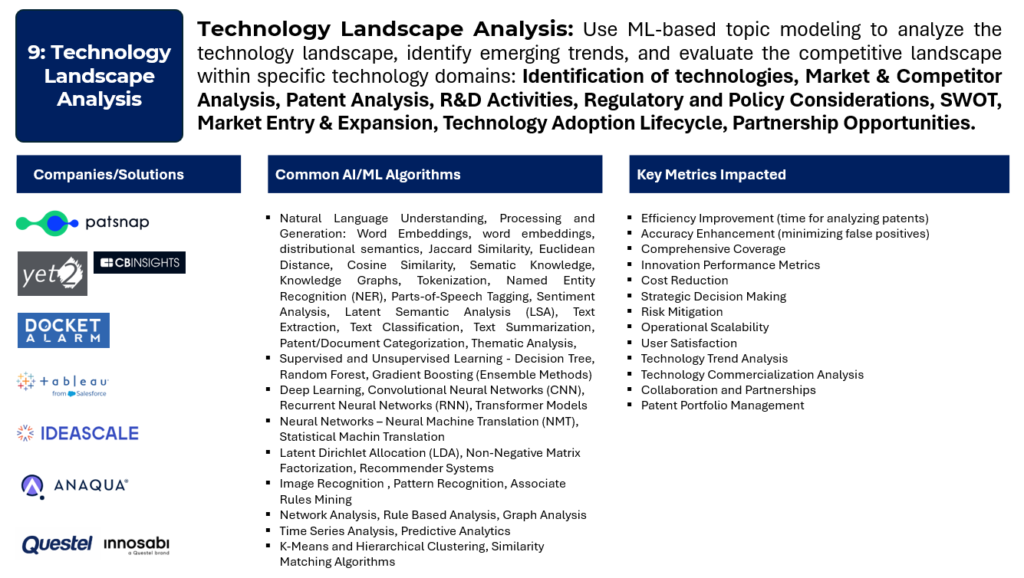Artificial Intelligence (AI) and Machine Learning (ML) can significantly impact patent management by automating and optimizing various tasks. By leveraging AI and ML in these areas, patent management processes can become more efficient, accurate, and proactive, ultimately enhancing the overall effectiveness of intellectual property management strategies. There are several applications and areas where AI/ML can be applied in patent management: Prior Art Search, Automated Patent Drafting, Patent Classification, Patent Valuation, Automated Patent Filing and Prosecution, Patent Portfolio Management, Patent Analytics, Infringement Detection, Technology Landscape Analysis, Patent Litigation Support, Automated Patent Maintenance and Collaborative Innovation Platforms.
I: Technology Landscape Analysis
Technology landscape analysis refers to the systematic examination and assessment of the current state and trends within a specific technological domain or field. The goal of technology landscape analysis is to gain a comprehensive understanding of the various technologies, innovations, key players, research trends, and potential areas for development within a given area of interest. This analysis is valuable for decision-making, strategic planning, and innovation management. AI/ML is leveraged for technology landscape analysis to provide organizations with insights into emerging trends, competitive intelligence, and strategic opportunities within a specific technological domain. Technology landscape analysis involves examining the patent landscape, scientific literature, and other relevant data sources to identify patterns, trends, and potential areas for innovation.
Many companies in the field of business intelligence, data analytics, and innovation management leverage AI and ML technologies to enhance technology landscape analysis. These technologies are often integrated into broader platforms that support various aspects of data analysis, market research, and innovation strategy. Companies like Tableau, Qlik, and Microsoft Power BI may incorporate AI and ML features for analyzing and visualizing technology landscapes. Platforms such as Innosabi, IdeaScale, or Spigit may use AI/ML to analyze innovation trends, identify emerging technologies, and facilitate collaborative idea generation. Companies like Anaqua, Docket Alarm, or PatSnap may integrate AI/ML for patent analysis, helping in technology landscape assessment and competitive intelligence. Platforms designed for technology scouting and open innovation, like Yet2 or Wellspring, may utilize AI/ML for scanning technology landscapes and identifying opportunities. Companies providing market research and insights, such as CB Insights or Gartner, may leverage AI and ML for analyzing technology trends and competitive landscapes. Consulting firms specializing in technology or innovation strategy may develop custom solutions for technology landscape analysis using AI and ML. Emerging startups may focus on providing specialized tools or platforms that use AI and ML for technology landscape analysis. Keeping an eye on the startup ecosystem may reveal innovative solutions.
Technology landscape analysis refers to the systematic examination and assessment of the current state and trends within a specific technological domain or field. The goal of technology landscape analysis is to gain a comprehensive understanding of the various technologies, innovations, key players, research trends, and potential areas for development within a given area of interest. This analysis is valuable for decision-making, strategic planning, and innovation management. Technology landscape analysis provides organizations with valuable insights for making informed decisions related to research and development, investment, market positioning, and strategic planning. It enables them to navigate the complexities of the technological landscape, identify opportunities for growth, and stay competitive in rapidly evolving industries:
Identification of Technologies: Clearly defining the scope of the analysis by specifying the technologies, industries, or sectors to be included. Technology Classification: Categorizing and identifying relevant technologies within the defined scope. Market and Competitor Analysis: Assessing the key players, companies, and organizations active in the technology space. AI tools analyze the patent portfolios of competitors, identifying strengths, weaknesses, and potential areas for collaboration or differentiation. Provides organizations with a competitive advantage by understanding the technological positioning of competitors. Semantic Analysis: AI employs semantic analysis to understand the context, meaning, and technical details within patent documents, scientific literature, and other technical documents. Enhances the precision of technology landscape analysis by considering the semantic context of technologies.

Market Dynamics: Understanding market trends, dynamics, and factors influencing technology adoption. Patent Analysis: Identification of Patents: Analyzing patent databases to identify relevant patents within the chosen technology domain. Innovation Trends & Predictive Analysis: Identifying patterns and trends in patent filings to understand innovation within the landscape. Machine learning models predict future technology trends based on historical data, helping organizations stay ahead of emerging developments. Enables proactive decision-making and innovation strategy development. Literature and Research Analysis: AI/ML algorithms analyze scientific literature and research papers to identify key areas of innovation and scientific advancements. Expands the scope of technology landscape analysis by incorporating insights from academic and research communities. Patent Mapping and Clustering: AI algorithms analyze large patent datasets to map and cluster patents based on similarities and technology domains. Provides a visual representation of the technology landscape, making it easier to identify clusters of related patents and emerging trends.
Research and Development Activities: Reviewing academic and industry research publications to identify ongoing R&D efforts. Collaborations and Partnerships: Examining collaborative initiatives and partnerships within the research community. Emerging Technologies and Trends: Identifying new and emerging technologies that may impact the landscape. Trend Analysis: Assessing the direction and trajectory of technological trends. Regulatory and Policy Considerations: Understanding the regulatory environment and any legal or policy considerations affecting the technology domain. Intellectual Property Policies: Considering the impact of intellectual property laws and policies on innovation and technology development. SWOT Analysis: Conducting a SWOT analysis to identify internal and external factors influencing the technology landscape.
Market Entry and Expansion Strategies: Evaluating opportunities for market entry or expansion based on the analysis. Risk Assessment: Identifying potential risks and challenges associated with entering or expanding within the technology landscape. Collaboration and Partnership Opportunities: Opportunities: Assessing opportunities for collaboration with other organizations, research institutions, or industry partners. Exploring potential strategic alliances to strengthen the organization’s position in the technology landscape. Technology Adoption Lifecycle: Analyzing where technologies are positioned on the adoption curve, from early-stage development to widespread use. Understanding the maturity level of technologies within the landscape. Innovation Ecosystem Mapping: Mapping innovation hubs, clusters, or regions where significant technological advancements are taking place. Identifying key players contributing to the innovation ecosystem. Business Model Innovation: Evaluating existing and potential business models associated with the identified technologies. Exploring different ways to monetize innovations within the landscape.
Automating technology landscape analysis involves the use of various AI/ML algorithms to extract insights from large datasets, identify patterns, and make informed decisions. The specific algorithms used can depend on the nature of the analysis, the type of data involved, and the objectives of the analysis. The selection of algorithms depends on the specific goals of the technology landscape analysis. Often, a combination of these algorithms is used in an integrated approach to provide a holistic understanding of the technology ecosystem and facilitate informed decision-making: Natural Language Processing (NLP): Understanding and extracting information from textual data, such as research papers, articles, and patents. Summarization, topic modeling, sentiment analysis. Machine Learning for Text Classification: Categorizing and classifying documents based on their content.Document categorization, thematic analysis. Clustering Algorithms: Grouping similar entities or documents based on certain features. Identifying technology clusters, grouping similar patents or research papers.
Topic Modeling: Identifying topics or themes within a collection of documents. Extracting key themes from research literature, identifying emerging technologies. Semantic Analysis: Understanding the meaning and relationships between words or concepts. Enhancing the precision of search and analysis, identifying semantic connections. Predictive Analytics: Forecasting future trends or developments based on historical data. Predicting emerging technologies, forecasting market trends. Supervised Machine Learning: Training models using labeled data to make predictions or classifications. Predicting technology adoption, classifying technologies into categories. Unsupervised Machine Learning: Discovering patterns or structures in data without labeled examples. Identifying hidden relationships between technologies, clustering similar technologies.
Graph Analysis: Analyzing relationships between entities in a network. Mapping collaborations, identifying influential players in a technology ecosystem. Decision Trees and Random Forests: Making decisions based on a series of conditions. Technology selection criteria, decision-making in technology landscape strategy. Association Rule Mining: Discovering interesting relationships or associations between variables. Identifying co-occurrences or patterns within technology datasets. Deep Learning (Neural Networks): Learning complex patterns in large datasets. Pattern recognition, feature extraction, image and speech analysis. Sentiment Analysis: Determining the sentiment expressed in textual data. Assessing public sentiment towards specific technologies or innovations. Pattern Recognition: Identifying consistent patterns or trends in data. Recognizing recurring elements in patent claims, identifying technology trends.
Automating technology landscape analysis using AI and ML can bring several benefits, impact various metrics, and contribute to achieving key performance indicators (KPIs) for organizations. Efficiency Metrics: Time Saved in Analysis. Reduction in the time required for collecting, processing, and analyzing technology-related data. Increased efficiency, faster decision-making, and the ability to respond quickly to emerging trends. Accuracy Metrics: Measurement of the accuracy in identifying relevant technologies (precision) and the ability to capture all relevant technologies (recall). Improved accuracy in understanding the technology landscape and identifying key trends. Comprehensive Coverage: Breadth of Analysis.Assessment of the breadth and coverage of the technology landscape analysis in terms of technologies, industries, and innovation sources. A more comprehensive understanding of the entire technology ecosystem. Strategic Decision-Making Metrics: Informed Decision Quality. Measurement of the quality of strategic decisions made based on technology landscape insights. Enhanced decision-making, better alignment with organizational goals, and improved strategic planning. Innovation Performance Metrics: Rate of Innovation Adoption. Measurement of the speed at which the organization can adopt and integrate new and relevant technologies. Increased innovation agility and the ability to stay ahead of competitors. Risk Mitigation Metrics: Assessment of the system’s ability to identify and mitigate potential risks associated with technology adoption. Improved risk management and reduced exposure to technological and market risks.
Operational Metrics: Evaluation of the system’s scalability to handle increasing volumes of technology-related data. Efficient handling of growing datasets and increased operational scalability. Cost Efficiency Metrics: Quantification of the reduction in costs associated with manual data collection and analysis. Improved cost-effectiveness in technology landscape analysis. Technology Trend Analysis: Measurement of the system’s effectiveness in identifying new and emerging technologies. Proactive adaptation to emerging trends and early exploration of new opportunities. Collaboration and Partnership Metrics: Collaboration Opportunities Identified. Assessment of the system’s ability to identify collaboration opportunities with external partners, researchers, or organizations. Strengthened collaborative networks and enhanced innovation ecosystems. User Satisfaction Metrics: Collection of feedback from users regarding the effectiveness and usability of the automated technology landscape analysis system. Increased user satisfaction and engagement with technology-related insights. Market Intelligence Metrics: Assessment of the system’s ability to identify opportunities for market entry based on technology landscape analysis. Improved market intelligence and strategic positioning. Customization and Adaptability Metrics: Evaluation of the system’s adaptability to custom requirements and specific industry needs. Tailored technology landscape insights that align with organizational goals. Patent Portfolio Management Metrics: Assessment of the system’s contribution to optimizing the organization’s patent portfolio. Streamlined and more effective patent portfolio management. Technology Commercialization Metrics: Measurement of the success rate in commercializing technologies identified through landscape analysis. Improved outcomes in technology commercialization efforts.
References
Technology Landscape Analysis:
Book: “Mastering the Business of Innovation: A Practical Guide to Effective Innovation Strategies” by Scott D. Anthony
Article: “Technological Landscape Analysis Using Patent Data: A Review” by Yuan Liu et al. (Scientometrics, 2016)
White Paper: “Technology Landscape Analysis: A Practical Guide” by Cipher
Course: “Technology Landscape Analysis” on WIPO Academy
Blog Post: “How to Perform a Technology Landscape Analysis” by PatSnap




